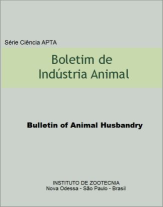Monensin: validation of polyclonal antibodies by immunoassay for food safety certification
Palavras-chave:
ELISA, ionophores, organic foodResumo
Monensin is an ionophoric antibiotic used to treat bacterial, fungal, and parasitic infections. Although it can be toxic to most livestock, at low dosages, it is recommended to increase the rate of weight gain and for prevention and control of coccidiosis due to Eimeria bovis and Eimeria zuernii in beef and dairy cattle kept in pasture or in dry feed lots. It mainly acts against gram positive bacteria. In the rumen, ionophoric substances accelerate protein degradation, decreasing the gas production during rumen fermentation. At higher levels, the addition of those ionophoric substances can lead to toxicological panel and even death of animals, such as horses. In the sugar and alcohol industry, monensin is used to control bacteria during fermentation. Therefore, yeast recycled from the alcohol-sugar industry is dried and used as supplementation for animal feed, mainly as a source of vitamins, especially of the B complex. The correct identification of residues from monensin in animal feed and meat, eggs and milk is important to determine the amount of monensin present in the biological matrix as well as for the certification of organic food, which must be monensin-free. This work aimed to validate polyclonal antibodies, produced in female New Zealand rabbits, to identify monensin by immunoassay. For the immunogenic activity, monensin was purified from a commercial product (20% monensin) and it was conjugated using the carbodiimides method of bio-conjugation. Antibodies were raised for 60 days and titrated by PTA-ELISA (plate trapped antigen enzyme-linked immunosorbent assay), at 565 nm, with horseradish peroxidase enzyme complex revelation system. Sera harvested each 15 days during the immunization schedule were diluted at 1:800 and titrated. Optical density (OD) values were 0.17, 0.19, 0.22 and 0.23 for day 15, 30, 45 and 60, respectively. Antibodies could detect monensin at concentration of 50 ng per mL in the premix supplement. Optimization tests are being conducted to identify monensin in biological matrix, from livestock feed with dried yeast or premix with monensin. The correct identification of whether food (meat, eggs or milk) is monensin€“free or not determines the consumer profile for acceptance of livestock products. Organic food needs to be certified and one of the best food safety tests is ELISA, in this case for monensin detection.
Downloads
Downloads
Publicado
Edição
Seção
Licença
Os autores não serão remunerados pela publicação de trabalhos, pois devem abrir mão de seus direitos autorais em favor deste periódico. Por outro lado, os autores ficam autorizados a publicar seus artigos, simultaneamente, em repositórios da instituição de sua origem, desde que citada a fonte da publicação original seja Boletim de Indústria Animal. A revista se reserva o direito de efetuar, nos originais, alterações de ordem normativa, ortográfica e gramatical, com vistas a manter o padrão culto da língua e a credibilidade do veículo. Respeitará, no entanto, o estilo de escrever dos autores. Alterações, correções ou sugestões de ordem conceitual serão encaminhadas aos autores, quando necessário. Nesses casos, os artigos, depois de adequados, deverão ser submetidos a nova apreciação. As opiniões emitidas pelos autores dos artigos são de sua exclusiva responsabilidade. Todo o conteúdo deste periódico, exceto onde está identificado, está licenciado sob a Licença Creative Commons Attribution (CC-BY-NC). A condição BY implica que os licenciados podem copiar, distribuir, exibir e executar a obra e fazer trabalhos derivados com base em que só se dão o autor ou licenciante os créditos na forma especificada por estes. A cláusula NC significa que os licenciados podem copiar, distribuir, exibir e executar a obra e fazer trabalhos derivados com base apenas para fins não comerciais.













